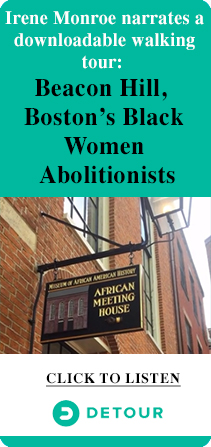Gentrification of neighborhoods always disrupts existing communities within them. Sometimes the disruption brought on by gentrification is expressed in anger and violence toward not only the transitional group ushering in the change but the existing denizens of the community.
In the pre-dawn hours of a Saturday in August, Islan Nettles, 21, who also went by the names Vaughn Nettles and Alon Nettles, was strolling and lollygagging with a group of her sister-friends on Frederick Douglass Boulevard between 147th and 148th Streets in Harlem. When she and the girls were recognized as transgender women, Paris Wilson, 20, began spewing homophobic epithets. Enraged by the sight of the women, Wilson crossed the street to where the women were and savagely pummeled Nettles, resulting in her death, because he’d allegedly been teased for flirting with a transgender woman.
Nettles’ death has shaken parts of Harlem, especially the Hamilton Heights community where Nettles was killed. In the last decade Hamilton Heights has gradually emerged as an LGBTQ community. A clear example of a new queer Harlem came in April 2010, when the Harlem Stage premiered the new documentary short film Marriage Equality: Byron Rushing and the Fight for Fairness and held the largest public dialogue on same-sex marriage by LGBTQ people of color in the country. New York native and award-winning African-American gay filmmaker Thomas Allen Harris directed the film, sponsored by the Human Rights Campaign.
In June 2010 Harlem saw its first Pride. But Harlem still remains both a complicated open and closeted queer social hotspot. Harlem’s transgender community wrestles more than any of us LGBQ people with Harlem’s homophobia and transphobia.
“In Harlem, it can be dangerous for transgenders to approach men,” Nutrive Fitness Studio and Juice Bar owner Dayan Jenniffer told DNAinfo New York. “Some of the men are very aggressive and close-minded. You have to be careful who you approach.”
The struggle of Harlem’s transgender community dates back, at least on record, to the early 1900s. By the time of the Harlem Renaissance, roughly from 1920 to 1935, LGBTQ African Americans carved out for themselves a queer space of self-expression. During this era Harlem’s transgender community was notoriously cheered and despised for their drag ball extravaganzas. Langston Hughes depicted the balls as “spectacles of color.” George Chauncey, author of Gay New York, wrote that during this period, “perhaps nowhere were more men willing to venture out in public in drag than in Harlem.” But for the most part, Harlem’s LGBTQ community was forced to be on the “down low.”
With a new, visible black LGBTQ face emerging in Harlem in the last decade, so too is a white one. When Manhattan rents became prohibitive — especially in Greenwich Village, New York City’s gay mecca — many LGBTQ Manhattanites took either a bridge over to Brooklyn or a train up to Harlem. According to Charles Kaiser, author of The Gay Metropolis: A History of Gay Life in New York, gay people have often been at the forefront of gentrification, both in New York and elsewhere in the U.S. And the number of whites in Harlem in the last decade has nearly doubled, from 9.9 percent to 16.6 percent of the neighborhood’s total population.
These new LGBTQ residents in predominately poor communities and communities of color have brought unimaginable improved services to an area that the city had long forgotten, like police protection, Starbucks, Whole Foods, and boutique shops, to name a few, but their presence has also created great resentment among those who, while not forced to relocate from these communities, are left to see the uncomfortable changes. I’m told that, oddly, the resentment toward white queer people taking up residence in Harlem has been expressed more openly toward black queer people, in the form of homophobic and transphobic slurs and attacks.
Asha Greene, a trans woman, and Maureen Ryan, a lesbian, are recent graduates from NYU. While attending NYU they lived in one of the school’s leased apartments but moved uptown when they realized that they couldn’t afford the rents in the area.
“My neighbor, who has lived in this building for over 20 years, never speaks to Maureen and barely speaks to me,” Asha said. “When she, on this rare occasion, spoke to me, it was because I helped her with her groceries. Expecting a ‘thank you,’ she said instead that she hated seeing the sight of me and my partner move in. She said to me, ‘See what you bringing up in here,’ referring to my girlfriend being white, ‘and she’ll be bringing more of her kind.’”
Transphobia in black communities leave members of our community, like Nettles, especially vulnerable. And our communities must be held accountable. While Harlem has always had a transgender community, it has never had to take seriously public charges of a hate crimes perpetrated against its transgender residents. Nettles’ mother, along with several Harlem LGBTQ groups, are contesting Wilson’s low bail, set at $2,000. Such a low bail sends no meaningful message about the crime and the value of the lives of its transgender residents.
In 2013 Harlem is unquestionably a community in transition — and not only with its new residents. The uptick of insults and assaults on Harlem’s predominately black LGBTQ communities, some contest, is largely because of gentrification, with a community’s feelings and frustrations wrongly expressed in both homophobic and transphobic ways.
Homo- and transphobia are forms of bigotry. Long-term residents of Harlem know bigotry all too well. Hopefully they won’t become experts on the other side too.



